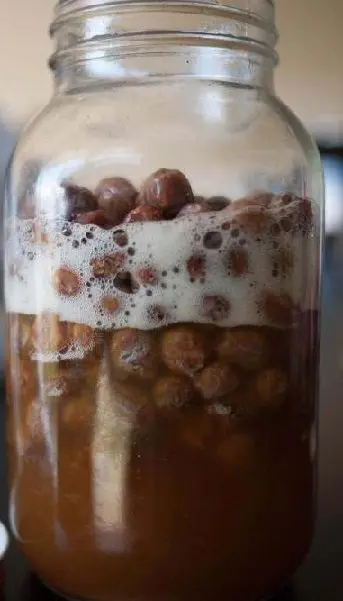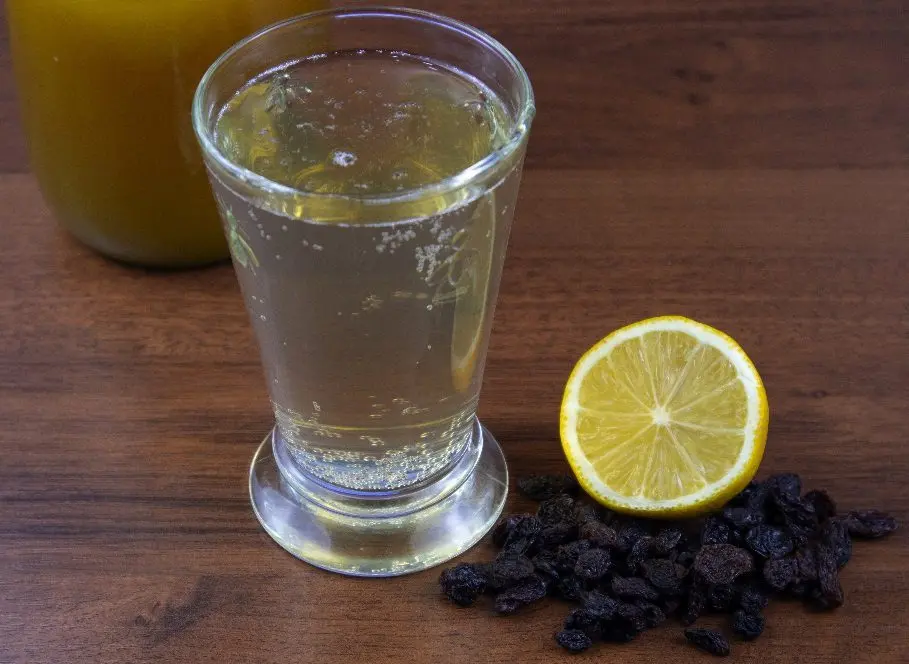Kvass from birch sap is a delicious, tonic, thirst-quenching non-alcoholic drink (alcohol content less than 0,5%), which is easy to make at home. At the same time, the recipe is relevant all year round, since not only fresh (necessarily not sour), but also canned birch sap, harvested in spring or bought in a store, is suitable for cooking.
Ingredients:
- birch sap – 5 liters;
- sugar (honey) – 200-250 grams;
- raisins (preferably large dark) – 50 grams;
- lemons – 2 pieces;
- yeast – 5 grams dry (25 grams pressed) or wine per 5 liters of must (optional).
Sugar can be replaced with liquid honey in the same proportions, while the color of kvass from white or pale yellow (depending on the raisins) will change to rich yellow or amber. In the classic version, raisins are not only responsible for the taste and color, but are also used as a source of wild yeast (located on the surface of the berries). Lemons contribute a light citrus aroma, promote fermentation, creating the right acidity in the wort, and give the drink a pleasant light sourness.
I advise you to make birch kvass without yeast (dry or pressed bakery), since their use significantly impairs the flavor. In fact, instead of kvass, mash is obtained. Cultural wine yeast (sold in stores) or wild yeast from raisins are suitable for this recipe. The correct activation of the latter is described at the first stage of preparation.
The authors of some birch sap kvass recipes offer to complement the taste of the drink with black bread, fermented malt, coffee beans, dried fruits, and even roasted barley. But the listed ingredients completely neutralize the already weak taste of birch sap, therefore they are only suitable for homemade kvass based on water or fruit juices with a high solids content: apple, plum, cherry, etc.
birch kvass recipe
1. 4-5 days before working with juice, activate wild yeast (relevant if there is no wine yeast and you don’t want to use regular yeast for baking).
The problem is that most modern raisins are processed with chemicals and preservatives for long-term storage, so not all berries will ferment. I advise you to immediately buy 3-4 types of raisins (preferably in different stores) and try each batch as a starter.
Technology: be sure to pour unwashed raisins into a sterilized jar, add 300 ml of water (birch sap) at a temperature of 20-28 ° C and 1 tablespoon of sugar. Tie the neck of the jar with gauze, transfer the future sourdough to a dark place at room temperature. Leave for at least 3-4 days for the wild yeast to activate.

When foam, hissing and a slight smell of fermentation appear on the surface, the starter is ready. If this does not happen, an unpleasant odor or mold has appeared, it means that due to the treatment with preservatives, there is no wild yeast left on the selected raisins and you will have to use another one, repeating the whole procedure from the beginning.
2. Filter birch sap through gauze folded in several layers to remove small particles of debris. Pour the juice into a fermentation container.
3. Scald lemons with boiling water, rinse in running water and wipe dry. Gently remove the zest from the fruit with a knife or vegetable peeler – the upper yellow part without white pulp, which gives bitterness.
4. Add the sourdough made at the first stage (along with raisins) or yeast, sugar or honey, lemon zest and juice (squeeze from the fruit), well-washed raisins (if cultured yeast is used) to the birch sap. Stir the wort until sugar (honey) is completely dissolved in water.
The water, sugar, and raisins used to make the starter should count towards the total ingredients.
5. Cover the neck of the fermentation tank with gauze to protect it from insects. Transfer the wort to a dark place with a temperature of 18-27°C and leave homemade birch kvass for 12-14 hours (on baker’s yeast – for 6-8 hours) for fermentation.
It is better not to overexpose the drink on fermentation, otherwise it will become alcoholic. The theoretical maximum possible strength is 3 degrees (if the yeast converts all the sugar into alcohol, but this takes at least a few days). Subject to the specified cooking technology, the alcohol content will be below 0,5%.
6. Filter the finished kvass from birch sap through several layers of gauze, pour into bottles for storage (preferably well-washed plastic ones), leaving 3-5 cm of free space from the neck. Close hermetically.
Filtered raisins can be used as a starter for new portions of kvass (stored in a hermetically sealed container in the refrigerator for up to 5 days), not included in the composition of the ingredients, but simply thrown in at the 2nd stage instead of wine yeast.
7. Keep the bottles for 30-60 minutes at room temperature (to saturate with carbon dioxide), then transfer to a refrigerator or cellar. After 1-2 hours, kvass is ready for use.
Attention! Periodically check the pressure in the bottles (plastic ones become very hard and “bloat”) and bleed the gas if necessary to prevent bursting.

Shelf life at temperatures from 0 to +8°C – 6 months. Open birch kvass is better to drink a day before.









